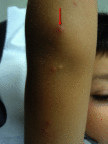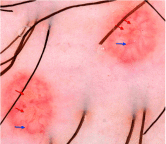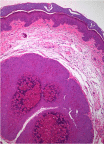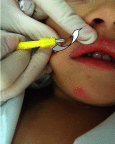Molluscum contagiosum: an update and review of new perspectives in etiology, diagnosis, and treatment
- PMID: 31239742
- PMCID: PMC6553952
- DOI: 10.2147/CCID.S187224
Molluscum contagiosum: an update and review of new perspectives in etiology, diagnosis, and treatment
Abstract
Molluscum contagiosum (MC) is a self-limited infectious dermatosis, frequent in pediatric population, sexually active adults, and immunocompromised individuals. It is caused by molluscum contagiosum virus (MCV) which is a virus of the Poxviridae family. MCV is transmitted mainly by direct contact with infected skin, which can be sexual, non-sexual, or autoinoculation. Clinically, MC presents as firm rounded papules, pink or skin-colored, with a shiny and umbilicated surface. The duration of the lesions is variable, but in most cases, they are self-limited in a period of 6-9 months. The skin lesions may vary in size, shape, and location, which is more frequent in immunosuppressed patients, and could present complications such as eczema and bacterial superinfection. The diagnosis is based on clinical findings. A useful clinical tool is dermoscopy. If the diagnostic doubt persists, confocal microscopy or skin biopsy could be performed. The need for active treatment for MC is controversial; however, there is a consensus that it should be indicated in cases of extensive disease, associated with complications or aesthetic complaints. There are several treatment modalities which include mechanical, chemical, immunomodulatory, and antivirals. The objective of this article is to review the current evidence in etiology, clinical manifestations, diagnosis, and management alternatives of MC.
Keywords: confocal microscopy; dermoscopy; eczema molluscorum; molluscum contagiosum; molluscum contagiosum virus; treatment.
Conflict of interest statement
The authors do not have any conflicts of interest to declare in this work.
Figures





References
-
- van der Wouden JC, Menke J, Gajadin S, et al. Interventions for cutaneous molluscum contagiosum. Cochrane Database Syst Rev. 2017;5:CD004767. - PubMed
Publication types
Grants and funding
LinkOut - more resources
Full Text Sources

